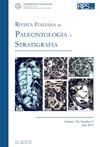两种晚三叠世drepanosaurormorph - diapsid巨角龙后肢解剖结构的差异表明其栖息地在树栖环境中的划分
IF 1.9
3区 地球科学
Q2 GEOLOGY
引用次数: 0
摘要
在三叠纪drepanosaromorph diapsid Megalancosaurus的标本中发现了两种不同的后肢形态,导致该属中两个不同的物种:M. preonensis和M. endennae。在本研究中,对两种巨角龙的后肢结构的重新研究表明,M. preonensis和M. endennae在树栖环境中利用了不同的微栖息地,就像许多属于同一属的现存物种一样,如加勒比Anoles。M. endennae具有更强壮的小腿,更大的抓脚,对生的无爪拇,脚趾2-5上的爪更深且更弯曲,更适合在狭窄而复杂的支撑物上运动,如末端树枝上的窄枝。M.preonensis后肢更纤细,没有相对的拇趾,所有趾趾上的爪子更长但更薄,更少弯曲,这可能更适合生活在更大的支撑物上,也可能像树懒一样把长脚爪用作钩子。在这两个巨角龙物种中,尾巴既可以作为支撑来保持稳定的三脚架步态,也可以作为一种附着装置来确保在桥接期间的抓地力,就像其他树栖drepanosaromorphs一样,骨骼是充分了解的。巨角龙的整体后肢适应更类似于一些小型树栖哺乳动物,而不是变色龙。本文章由计算机程序翻译,如有差异,请以英文原文为准。
DIFFERENCES IN THE HINDLIMB ANATOMY IN THE TWO SPECIES OF THE LATE TRIASSIC DREPANOSAUROMORPH DIAPSID MEGALANCOSAURUS INDICATE HABITAT PARTITIONING WITHIN THE ARBOREAL ENVIRONMENT
Discovery of two different morphologies of the hindlimb in specimens ascribed to the Triassic drepanosauromorph diapsid Megalancosaurus led to the erection of two distinct species within this genus: M. preonensis and M. endennae. In the present study a re-examination of the hindlimb architecture of both Megalancosaurus species indicates that M. preonensis and M. endennae exploited different microhabitats within the arboreal environment as for many extant species belonging to the same genus, like caribbean Anoles. M. endennae, with a stronger lower leg, a larger grasping foot, an opposable clawless hallux, and deeper and more recurved claws on pedal digits 2-5 was better adapted for locomotion on narrow and intricate supports like narrow twigs on terminal branches. M.preonensis with more slender hindlimbs, absence of an opposable hallux and longer, but thinner and less recurved claws on all pedal digits may have been better adapted to live on larger supports and could also have used the long pedal claws as hooks in a sloth-like fashion. In both Megalancosaurus species the tail acted both as a prop to assume a stable tripodal gait and as a clinging device that ensured grip during bridging as in other arboreal drepanosauromorphs which skeleton is adequately known. The overall hindlimb adaptation of Megalancosaurus species are more similar to that of some small arboreal mammals rather than that of chameleons.
求助全文
通过发布文献求助,成功后即可免费获取论文全文。
去求助
来源期刊
CiteScore
3.60
自引率
4.30%
发文量
28
审稿时长
>12 weeks
期刊介绍:
The Rivista Italiana di Paleontologia e Stratigrafia was founded in 1895. It publishes original papers dealing with all fields of paleontology and of stratigraphy, from Italy and the Mediterranean to the Tethys, as well across the globe from China to North America.

 求助内容:
求助内容: 应助结果提醒方式:
应助结果提醒方式:


